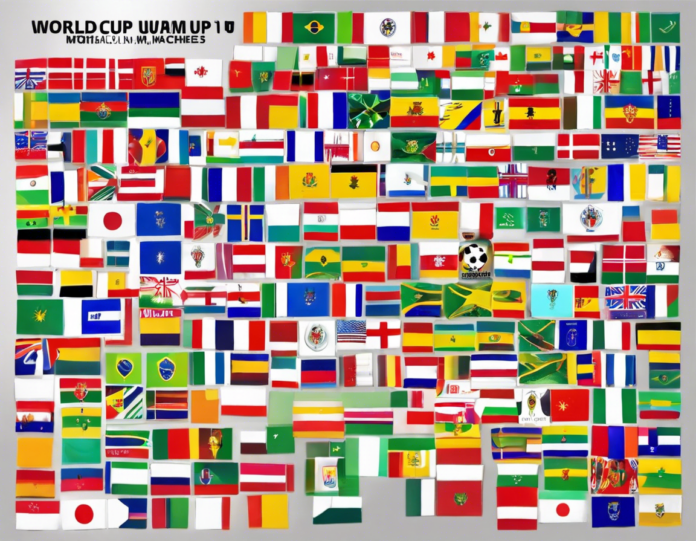As the biggest sporting event in the world, the FIFA World Cup captivates billions of viewers every four years. Fans and teams alike eagerly anticipate the tournament, with countries vying for a chance to lift the prestigious trophy and claim soccer supremacy. While the World Cup itself is the ultimate stage for teams to showcase their skills and compete against the best in the world, warm-up matches serve as crucial preparation leading up to the main event. These matches serve as a testing ground for teams to fine-tune their strategies, assess player performance, and build momentum before the tournament kicks off.
The Importance of Warm-Up Matches
- Warm-up matches play a pivotal role in team preparation for the World Cup. They offer an opportunity for squads to experiment with tactics, formations, and player combinations in a competitive setting.
- These matches provide valuable insights into the team’s strengths and weaknesses, allowing coaches to adjust their game plans accordingly.
- Warm-up matches also help players acclimatize to the conditions they will face during the tournament, such as climate, pitch conditions, and time zone differences.
- Additionally, these matches offer a chance for players to build chemistry and cohesion on the field, essential for success in a high-stakes tournament like the World Cup.
Strategies for Success
- Player Rotation: Coaches often use warm-up matches to evaluate different players and give everyone in the squad an opportunity to showcase their skills. This rotation helps identify the best combinations and ensures that the team is prepared for any eventuality during the World Cup.
- Focus on Fitness: Fitness is paramount in a tournament as demanding as the World Cup. Warm-up matches allow teams to assess the fitness levels of their players, identify any weaknesses, and tailor training programs to address these issues.
- Mental Preparation: In addition to physical fitness, mental readiness is crucial for success in the high-pressure environment of the World Cup. Warm-up matches provide players with a chance to acclimatize to the pressure and intensity of international competition.
- Analyzing Opponents: Warm-up matches against different teams offer valuable insights into the playing styles and tactics of potential opponents in the World Cup. Coaches can use these matches to devise strategies to counteract the strengths of rival teams.
Key Considerations
- Injuries: While warm-up matches are essential for team preparation, the risk of injuries is always present. Coaches must balance the need for match practice with the risk of players getting injured before the tournament.
- Form Versus Rest: Coaches must strike the right balance between giving players enough playing time to find their form and ensuring they get adequate rest to avoid burnout before the World Cup.
- Team Chemistry: Building team cohesion is critical for success in the World Cup. Warm-up matches provide an opportunity for players to develop understanding and rapport on the field.
Maximizing Performance
- Set Goals: Coaches should establish clear objectives for each warm-up match, whether it be experimenting with tactics, evaluating player performance, or building team chemistry.
- Feedback and Analysis: After each match, coaches should conduct detailed reviews to assess the team’s performance, identify areas for improvement, and make any necessary adjustments.
- Continual Improvement: Use warm-up matches as stepping stones for progress, aiming to peak at the right time during the World Cup. Each match should serve as a building block towards optimal performance in the tournament.
Frequently Asked Questions (FAQs)
-
How many warm-up matches do teams typically play before the World Cup?
Teams usually play between 2-4 warm-up matches leading up to the World Cup. The number may vary depending on the preferences of the coaching staff and the tournament schedule. -
Do warm-up matches impact a team’s performance in the World Cup?
Warm-up matches can have a significant impact on a team’s performance in the World Cup. They play a crucial role in shaping tactics, assessing player form, and building team chemistry. -
Are warm-up matches televised or open to the public?
Warm-up matches are often televised, allowing fans to get a glimpse of their team’s preparations. Some matches may be open to the public, while others are held behind closed doors for privacy and tactical reasons. -
How do coaches approach team selection for warm-up matches?
Coaches typically use warm-up matches to evaluate different players, test out tactical variations, and assess fitness levels. They may experiment with different lineups to find the best combination for the World Cup. -
Can warm-up matches help teams acclimatize to playing in different countries?
Yes, warm-up matches provide teams with an opportunity to familiarize themselves with the playing conditions in the host country and adapt to factors like climate, pitch surfaces, and time zone differences. -
What happens if a player gets injured during a warm-up match?
Injuries during warm-up matches can be a cause for concern, as they may impact a player’s availability for the World Cup. Coaches must have contingency plans in place and may need to make adjustments to the squad if a key player gets injured. -
Do teams approach warm-up matches differently based on their group opponents in the World Cup?
Coaches may tailor their approach to warm-up matches based on the playing styles and strengths of their group opponents in the World Cup. They may use these matches to test strategies that could be effective against specific teams in the tournament. -
Can warm-up matches help teams build momentum for the World Cup?
Yes, strong performances in warm-up matches can help teams build momentum and confidence heading into the World Cup. A series of positive results can instill belief within the squad and set the tone for a successful tournament campaign. -
Are there any restrictions on the number of substitutions allowed in warm-up matches?
FIFA regulations allow for a maximum of six substitutions in each warm-up match, with teams typically using these opportunities to give playing time to different squad members and assess their options before the World Cup. -
Do teams prioritize winning warm-up matches or experimenting with tactics and player combinations?
While winning is always a positive outcome, teams often prioritize using warm-up matches to experiment with different tactics, formations, and player combinations. The ultimate goal is to fine-tune the team for success in the World Cup rather than solely focusing on results in warm-up matches.









